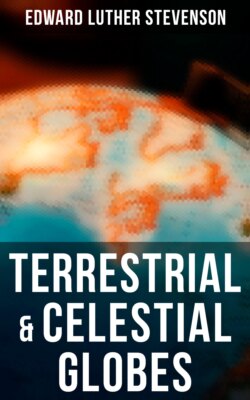Читать книгу Terrestrial & Celestial Globes - Edward Luther Stevenson - Страница 13
На сайте Литреса книга снята с продажи.
NOTES
Оглавление70 Beazley’s monumental work, previously cited, considers the geographical knowledge of the Christian middle ages, from the closing years of the Western Roman Empire to the early years of the fifteenth century. See especially Vol. I, chap. vi; Vol. II, chap. vi; Vol. III, chap. vi. Marinelli, G. Die Erdkunde bei den Kirchvätern. Leipzig, 1884; Kretschmer, K. Die physische Erdkunde im christlichen Mittelalter. Wien, 1889; Cosmas Indicopleustes. Christian Topography, tr. by J. M. McCrindle. (In: Hakluyt Society Publications. London, 1897); Günther, S. Die kosmographischen Anschauung des Mittelalters. (In: Deutsch. Rundschau für Geographie und Statistik. Vol. IV, pp. 135 ff.)
71 Zöckler, O. Geschichte der Beziehungen zwischen Theologie und Naturwissenschaft. Gütersloh, 1877. pp. 122 ff.; White, AD A History of the Warfare of Science with Theology in Christendom. New York, 1895–1897. See especially chaps. ii-iii. See also references in note 1.
72 Isaiah, chap. xl, v. 20; Ezechiel, chap. xxxviii, v. 12; Job, chap, xxvi, v. 7, 10; Psalm cxxxvi, 6.
73 Note summary and citations in Kretschmer, op. cit.
74 Note citations in Kretschmer, op. cit.
75 See his works, Etymologia, 3, 24–71, and De natura rerum, 9–27. Brehaut, E. An Encyclopedist of the Dark Ages. Isidore of Seville. (In: Studies in History, Economics and Public Law, Columbia University. New York, 1912. Vol. xlviii, No. 1.)
It must be admitted that there is considerable incoherence in the views of the world as expressed by the great majority of the mediaeval writers. One not infrequently lands in confusion when undertaking an investigation of their opinions.
76 Beda. Opuscula scientifica. Ed. by J. A. Giles. London, 1843. See De natura rerum, chap. xlvi, titled, “Terram globo similem.”
77 West, A. F. Alcuin and the Rise of Christian Schools. New York, 1892; Mullinger, J. B. The Schools of Charles the Great. New York, 1911; Fellner, R. Kompendium der Naturwissenschaften an der Schule zu Fulda. Berlin, 1879.
The real founder of the monastic schools was Hrabanus Maurus, who was a pupil of Alcuin, and who carried to the monastery of Fulda that Englishman’s love for the Quadrivium.
78 Günther, S.-Fiorini, M. Erd- und Himmelsgloben. Leipzig, 1895. p. 19.
79 Specht, F. A. Geschichte des Unterrichtswesen in Deutschland von den ältesten Zeiten bis zur Mitte des XIII Jahrhunderts. Stuttgart, 1885. pp. 127 ff.
80 Günther-Fiorini, op. cit., p. 18, n. 4, refers to a star map made in the monastery of St. Emeran in the early fifteenth century, and now belonging to the K. K. Hof- und Staats-Bibliothek of Munich, which was intended for a “Compositio spere solido.”
81 Arx, J. v. Geschichte des Kantons St. Gallen. St. Gallen, 1810. p. 265.
82 Büdinger, M. Über Gerberts wissenschaftliche und politische Stellung. Marburg, 1851; Werner, K. Gerbert von Aurillac, die Kirche und die Wissenschaft seiner Zeit. Wien, 1878.
83 Büdinger, op. cit., p. 38.
84 Specht, op. cit., pp. 138–139; Dummler, E. Ekkehart IV von St. Gallen. (In: Zeitschrift für deutsches Altertum. Berlin, 1869. Neue Folge, Vol. 2, p. 23.) The implication in the last named work seems to be that globes were used in many of the schools of this early day. Mabillon, J. Veterum analectorum. Paris, 1676. Tom. 2, p. 212. The statement here made clearly refers to the use of globes in astronomical instruction.
85 Gerbert, Letters of, 983–997, publiées avec une introduction et des notes par J. Havet. Paris, 1889. See especially Nos. 134, 148, 152, 162. Gerbert refers, in these letters to Remigius, to a globe which he intended to construct.
86 Lelewel, op. cit., Vol. II, p. 2.
87 Raumer, F. v. Geschichte der Hohenstaufen und ihre Zeit. Leipzig, 1878. Vol. III, p. 493. This astronomical tent has sometimes been referred to as a globe.
88 Libros del Saber de Astronomia del Rey D. Alfonso X de Castilla. Compilados, anotados y comentados por Don Manuel Rico y Sinobas. Madrid, 1863–1867. See especially Vol. I, pp. 153 ff.
89 Enciclopedia Universal illustrada, “Campano”; Tiraboschi, G. Storia della letteratura italiana. Roma, 1782–1785. Tom. IV, lib. ii, cap. ii, §v; Fiorini. Sfere terrestri. pp. 40–56.
There are numerous manuscripts of Campano to be found in the University Library of Bologna, in the Ambrosiana of Milan, and in the Library of San Marco in Venice. Fiorini refers to a number of writers who may be said to have followed and in part copied Campano.
90 Albertus Magnus. Liber de coelo et mundo. Lib. II 4, c. 9. For a short biography of Albertus see Encyclopaedia Britannica, “Albertus Magnus.”
91 Günther, S. Geschichte des mathematischen Unterrichtes, im deutschen Mittelalter bis zum Jahre 1525. Berlin, 1887. pp. 184 ff.
92 Catalogue of Printed Books in the British Museum contains a list of more than fifty editions, the first being printed in the year 1472.
93 Biographies are numerous. See Dictionary of National Biography, “Roger Bacon,” with bibliographical list. See Bacon’s Opus Magnus, lib. I, 152–153, “necesse est vero mundum extra habere figuram spericam …”; also lib. IV, in which he treats of the form of the earth.
94 See for a short biography Nouvelle biographie. Paris, 1866. “Thomas d’Aquin.”
95 Bourgeat, J. B. Études sur Vincent de Beauvais. Paris, 1856.
96 Biographies of Dante are numerous. See his Purgatorio, Canto XXVII, lines 1–4, referring to midday on the Ganges when it is dawn in Jerusalem; see also his Aqua et Terra, wherein he gives expression to a belief in the spherical theory.
